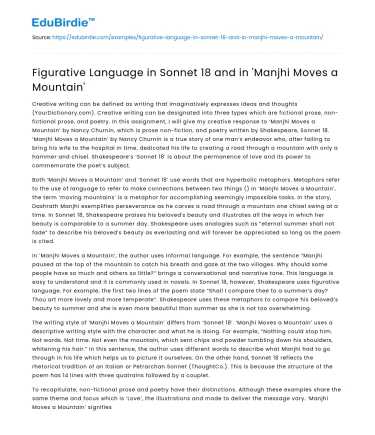Creative writing can be defined as writing that imaginatively expresses ideas and thoughts (YourDictionary.com). Creative writing can be designated into three types which are fictional prose, non-fictional prose, and poetry. In this assignment, I will give my creative response to ‘Manjhi Moves a Mountain’ by Nancy Churnin, which is prose non-fiction, and poetry written by Shakespeare, Sonnet 18. ‘Manjhi Moves a Mountain’ by Nancy Churnin is a true story of one man’s endeavor who, after failing to bring his wife to the hospital in time, dedicated his life to creating a road through a mountain with only a hammer and chisel. Shakespeare’s ‘Sonnet 18’ is about the permanence of love and its power to commemorate the poet’s subject.
Both ‘Manjhi Moves a Mountain’ and ‘Sonnet 18’ use words that are hyperbolic metaphors. Metaphors refer to the use of language to refer to make connections between two things () In ‘Manjhi Moves a Mountain’, the term ‘moving mountains’ is a metaphor for accomplishing seemingly impossible tasks. In the story, Dashrath Manjhi exemplifies perseverance as he carves a road through a mountain one chisel swing at a time. In Sonnet 18, Shakespeare praises his beloved's beauty and illustrates all the ways in which her beauty is comparable to a summer day. Shakespeare uses analogies such as “eternal summer shall not fade” to describe his beloved’s beauty as everlasting and will forever be appreciated so long as the poem is cited.
Save your time!
We can take care of your essay
- Proper editing and formatting
- Free revision, title page, and bibliography
- Flexible prices and money-back guarantee
In ‘Manjhi Moves a Mountain’, the author uses informal language. For example, the sentence “Manjhi paused at the top of the mountain to catch his breath and gaze at the two villages. Why should some people have so much and others so little?” brings a conversational and narrative tone. This language is easy to understand and it is commonly used in novels. In Sonnet 18, however, Shakespeare uses figurative language. For example, the first two lines of the poem state “Shall I compare thee to a summer’s day? Thou art more lovely and more temperate”. Shakespeare uses these metaphors to compare his beloved’s beauty to summer and she is even more beautiful than summer as she is not too overwhelming.
The writing style of ‘Manjhi Moves a Mountain’ differs from ‘Sonnet 18’. ‘Manjhi Moves a Mountain’ uses a descriptive writing style with the character and what he is doing. For example, “Nothing could stop him. Not words. Not time. Not even the mountain, which sent chips and powder tumbling down his shoulders, whitening his hair.” In this sentence, the author uses different words to describe what Manjhi had to go through in his life which helps us to picture it ourselves. On the other hand, Sonnet 18 reflects the rhetorical tradition of an Italian or Petrarchan Sonnet (ThoughtCo.). This is because the structure of the poem has 14 lines with three quatrains followed by a couplet.
To recapitulate, non-fictional prose and poetry have their distinctions. Although these examples share the same theme and focus which is ‘Love’, the illustrations and mode to deliver the message vary. ‘Manjhi Moves a Mountain’ signifies a man who gave a part of his life to help others so that they would not suffer the faith of his beloved wife in a descriptive story form whereas Sonnet 18 displays a man’s appreciation towards his lover’s beauty through comparisons with other objects.
References
- Churnin, N. (2017) Manjhi Moves a Mountain. Creston Books.






 Stuck on your essay?
Stuck on your essay?

